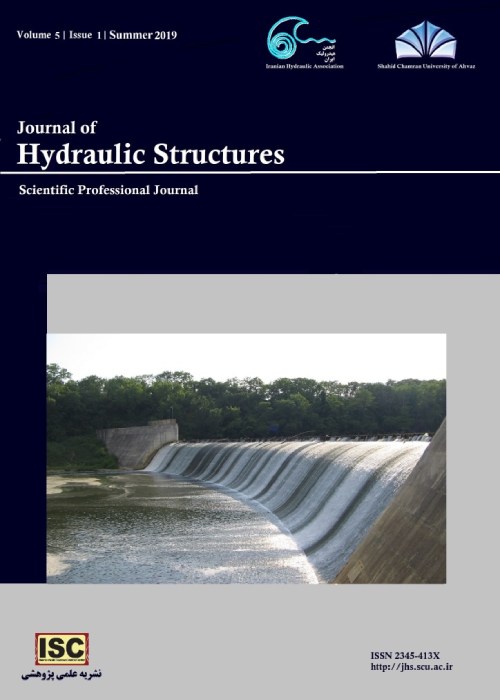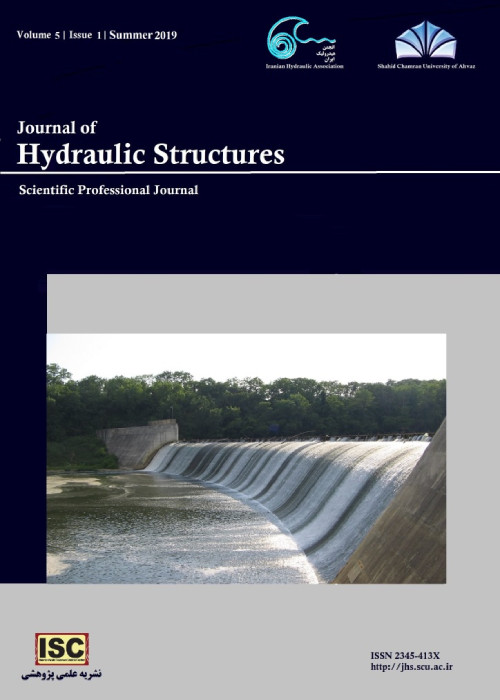فهرست مطالب

Journal of Hydraulic Structures
Volume:9 Issue: 1, Spring 2023
- تاریخ انتشار: 1402/03/30
- تعداد عناوین: 6
-
-
Pages 1-17The Arvand River forms the border between Iran and Iraq and is the only permanent river discharging into the Persian Gulf(PG). It is a tidal river adversely affected by sedimentation,which is more likely resulted from tidal asymmetry. The tidal barrier(TB) has remarkable effects on the tidal regime. To assess these effects on the tidal waves asymmetry,it is critical to study the two main factors of closure percentage(CP) and closure duration(CD). This manuscript aims to investigate the tidal barrier effect on the asymmetry of the tidal waves propagating through the estuary. To evaluate tidal asymmetry,Tidal Asymmetry Index(TAI) is introduced based on the relative phase angle of the M2 and M4 components through the river. A two-dimensional Delft3D hydrodynamic model is utilized. The tidal wave is flood dominant, and its relative phase angle increased slightly, from 90 to 135 degrees in Km 40 and then decreased to just under 90 degrees near the Abadan(65km) and constant along the Abadan to Khorramshahr. The tidal barrier has changed the tidal regime in the river which leads to relatively constant tidal asymmetry during the 45km upward. To reach the highest TAI, a closure percentage and duration of 55% and 180 minutes are estimated. The tidal barrier operation also adversely affects the amplitude of the M2 and M4 components. M4 component amplitude increases before reaching the TB and then decreases. The decrease is more elaborated from kilometer 45 onward. Increasing the closure percentage amplifies the changes described above,but it has little effect on the general trends.Keywords: Arvand Estuary, Sediment, Tidal asymmetry, Tidal barrier, Persian Gulf
-
Pages 18-42Here, the effect of sill application on hydraulic jump parameters has been investigated. The model of sills is made of polyethylene in various dimensions. The sills were investigated in different positions relative to the gate in single, double, and triple arrangements. In a certain opening, the sill leads to more energy dissipation. By increasing the ratio of initial depth to sequent depth, the ∆EAB/yA decreases. It occurs due to the convergence of initial and sequent depths. In the under gate suppressed sill state, the ∆EAB/EA is 11.05% more than the upstream tangential position, while it's 14.56% for downstream specific energy. The results showed that the energy dissipation decreases with increasing the opening by at most 34.88%. In the same opening of no-sill and with sill cases, the use of suppressed sill leads to a decrease in the sequent depth compared to the no-sill one. The application of the sill causes an increase in the initial depth and accordingly the initial specific energy decreases; therefore, the sill leads to the reduction of the specific energy in the flow conjugate depths. The regression nonlinear polynomial equations were proposed to estimate the relative energy dissipation. Statistical indicators Relative Error (RE), Root Mean Square Error (RMSE), and Kling Gupta Efficiency (KGE) have been used to check the accuracy of presented equations. The mean RE% and RMSE for presented equation of ∆EAB/EA are 0.78%, and 0.004, respectively. These values are 0.87%, and 0.009 for ∆EAB/EB, respectively. The KGE is in very good range for equations.Keywords: Relative energy dissipation, Corresponding depths, Hydraulic jump, Nonlinear regression equations
-
Pages 43-62
A numerical model is developed in this study using the finite element method (FEM) to estimate relative total uplift force for different positions of holes of drainage gallery in the foundation of Guangzhao gravity dam, located in China. The data of the relative total uplift force generated for different input combinations using the FEM were used to develop machine learning (ML) models. A three-layer Artificial Neural Network (ANN) and a new hybrid model known as ANN-Whale Optimization Algorithm (ANN-WOA) were used for this purpose. The results showed that R2, RMSE, NSE, KGE and RE% for ANN-WOA model in estimation of the relative total uplift forces were 0.998, 0.021, 0.989, 0.964 and 3.3% respectively and those for ANN model were 0.980, 0.023, 0.982, 0.953 and 4.67% respectively, which indicate the higher accuracy of ANN-WOA model compared to ANN model. The new hybrid model, ANN-WOA with the less RMSE and RE% and high KGE and NSE is a more appropriate model for the estimation of the relative total uplift force. The extracted metrics of violin plots indicated that the probability distribution of the relative total uplift force estimated using ANN-WOA model was very similar to that obtained using the FEM.
Keywords: Gravity dam, Uplift force, Finite element method, Hybrid artificial neural network-whale optimization algorithm -
Pages 63-80The use of gate-sill combinations in recent years has been one of the new methods in increasing the hydraulic performance of gates, including the discharge coefficient (Cd). The present research aims to investigate the Cd of the gate with a sill in different dimensions in width and various positions relative to the gate using support vector machine (SVM) models, the K nearest neighbor (KNN) algorithm, and the artificial neural network (ANN) method using Statistica software. Out of 345 experimental data, 70% (241) were used for training and 30% (104) for testing. The best results are obtained when all dimensionless parameters (Atotal/B2, H0/B, Z/B, ε/B, and X/B) are used. The results of different kernels showed that RBF kernel has better results in predicting Cd compared to Polynomial, Linear, and Sigmoid kernels. The results of the statistical indexes of R, KGE, RMSE, and Mean RE% for the RBF kernel in the test phase are 0.955, 0.90, 0.0192 and 1.82%, respectively. In the KNN model, Manhattan distance measure has favorable results compared to other Euclidean, Euclidean Squared, and Chebychev criteria. The results showed that the ANN method has the best performance compared to SVM and KNN models with values of 0.984, 0.976, 0.0098, and 1.15%, respectively.Keywords: Discharge Coefficient (Cd), Gate-Sill, SVM, KNN, ANN
-
Pages 81-97
There have been many dam removals around the world in recent decades due to safety issues, reservoir volume loss, and other factors. Sediments are deposited in dam reservoirs after years of operation, and sediment transfer downstream following dam removal requires further investigation. The aim of this research is to analyze and predict the effects of removing the dam on sediment transport, especially fine sediment transport on steep slopes. A case study of the Zonouz Dam in East Azerbaijan Province is used to demonstrate this. Sediment transport is predicted using a one-dimensional numerical model called DREAM1. Three sediment transport equations were considered for this grain size and slope to choose the most appropriate one. These equations include Brownlie, Smart and Rickenmann. Next, their results were collected for 350 laboratory experiments with conditions similar to modeling and the results were compared with each other. The calculations revealed a lower error in the Brownlie equation results. Sediment transport following the removal of the Zonouz Dam was modeled numerically for wet, dry, average, and recorded discharges. Based on the modeling results, erosion rates were high in the early years but decreased over time. Moreover, the dispersion mechanism is dominant over translation in the evolution of the pulse, resulting in sediments being transported downstream up to 11 kilometers. According to the results, approximately 82% of the sediments will be eroded after seven years under the hydrological conditions present at the Zonouz Dam.
Keywords: Dam removal, Sediment transport, DREAM, Zonouz Dam -
Pages 98-110
This study investigates the potential of Adaptive Neuro-fuzzy inference system (ANFIS), M5P, and Gaussian Process regression (GP) approaches to predict discharge coefficient (Cd) of chimney weir with different apex angles. Out of 110 data points, 77 arbitrarily selected observations were used for training, whereas the remaining 77 data points were used for testing. Input data consisted of h/p, y/p, L/p, and w/z, whereas Cd was an output. Four shapes of membership functions, i.e., triangular, trapezoidal, generalized bell-shaped, and Gaussian, were used for the ANFIS-based model development. Five different goodness-of-fit parameters and various graphical presentations were used to evaluate the performance of the machine-learning models. It was found that the M5P-based model was superior to other implemented models in predicting the Cd with Correlation Coefficient (CC) (0.9532 and 0.9472), Mean Absolute Error (MAE) (0.0024 and 0.0026), (Root Mean Square Error) RMSE (0.0032 and 0.0033), Scattering Index (SI) (0.0048 and 0.0050), and Nash Sutcliffe Efficiency (NSE) (0.9085 and 0.9925) values in the training and testing stages, respectively. Another major outcome of this study was that the ANFIS model was better than GP and other MFs-based ANFIS-ti models. The sensitivity of the Cd variables is also investigated, which showed h/p and L/p as major influencing factors in the Cd.
Keywords: ANFIS, GP, M5P, discharge coefficient, chimney weir


